You are reading the older HTML site
Positive Feedback ISSUE
november/december 2007

A Gaggle of Review Projects from the Good Doctor - Part Deux
In our first installment, I looked (albeit briefly) at the first batch of several components newly arrived to the Doctor's palatial ranch …but there were simply too many to address comfortably in one sitting. Some of these will probably endure long enough for an extended follow-up and some will not (for various reasons).
I understand this approach is at variance with what people are used to seeing (one piece, one extended review, one time) …but since this is how I listen, it makes sense to me that this is how I write.
Besides, I am reliably informed the attention span for reading in the US has declined to the point where the average citizen under thirty can barely remain focused long enough to read the directions on their IPod®. Apparently, the electronic generations are befuddled by naked text as brief as an Applebee's desert menu, so they are just resorting to pictures and prices.
Ah yes, life in the world of GUIs.
It is such a tragedy …if you can read with good comprehension you can actually educate yourself … and if you can't …you are dependent on externals sources …which should frighten everyone. Imagine generations who can only learn what they are taught …brrrrrrr; makes 1984 feel like soft-headed optimism. Is there anything better for a despot than a materialistic, uneducated population that is completely dependent upon what they are told and shown through controlled sources? Zowie!
Oh, and while I am on a rant …a quick note to the conspiracy-minded out there.
It has come to my attention there are allegations of various sorts about my nom de guerre, (think of it as a nom de plume on steroids) and the supposed secrecy surrounding my anthroponym.
Let me address this supposed conspiracy in two parts …the first is last year's Rocky Mountain Audio Fest where I wandered around for several days with both my proper name and "Dr. Sardonicus" on my name tag for all to see (oooh, secret!) …secondly, I can think of several times in just the past few months (including today) where readers' messages are forwarded to my personal email and addressed in print here at PFO in the "Reverberations" section with my NAME on them. So, if this is a mystery to you (like you should care anyway)… I might gently suggest you would be completely befuddled by a Hardy Boy mystery, or the old "got your nose" ploy.
Remember what Freud said, "sometimes a cigar is just a cigar."
And, with no further ado, let us begin with part two…
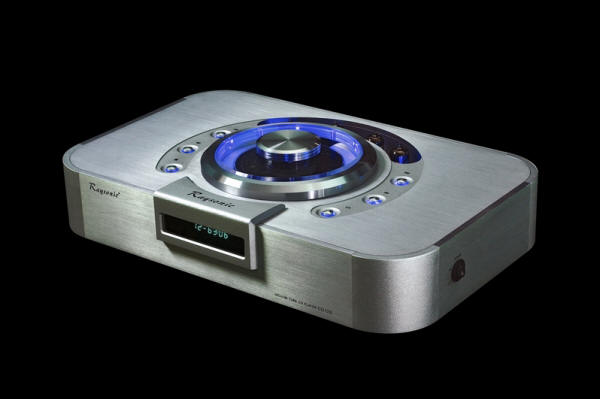
The Raysonic CD-128 CDP
Other than the sweet little REDGUM CDP that came along with the complete system for review from those enchanting Aussies, I have not done a stand-alone CDP review for eons …and for the most obvious of reasons. Along with David Robinson (Positive Feedback Online's Editor), I was one of the first-generation SACD adopters, and have not looked back.
I know that there are those who have carped about the RBCD performance of various SACD players, and in some cases their criticisms have been understandable …but I think these differences have pretty much faded with new, high-end models such as the EMM Labs and the Teac Esoteric. For me, the RBCD performance of the Marantz SA-7 is simply wonderful. I have both stellar SA and CD performance in one platform …I am happy.
But I recognize that, in spite of the continued steady release of both machines and materials, there are those who are convinced the format is due to disappear momentarily.
I also recognize that SACD has definitely settled in as a niche market and as such there will always be those who choose otherwise; so be it. I think more choice is always a better thing.
In all candor, however, I have been mostly unmoved by CDPs until we get to the really expensive ones, and then I always get wrapped around the axle of, "Why not just buy a good SACD-P, and not limit your options?"
My ambivalence has deepened with receipt of the shockingly adept Oppo 980 (under $150, and basically plays everything), and a bit of time with the new Teac Esoteric DV-60 universal player (which eschews the Technicolor sound so often heard with Esoterics) for a much more suave and less "in your face" presentation. (See David Robinson's review of this outstanding player elsewhere in Issue 34, at https://positive-feedback.com/Issue34/dv60.htm. There will be more to follow—if I can pry if from David's hands at some point.)
So, for me to do a stand alone CDP review …requires something special …and that something special is the Raysonic 128.
General
There are two strikingly unique features of the Raysonic, which are immediately apparent… the most obvious of which is its visual design. All rounded and curved with no sharp corners, no industrial gray or black box …the Raysonic is visually arresting; polished (or anodized) metal and throwing a charming drift of purple-tinted blue light. Most appealing.
Secondly, it is tubed (EH 6922s), which virtually beg for rolling. The tubes are housed in a semi-circular "well" on the top of the machine, bordering the disc cavity, and readily accessible. And, of course, there are a bunch of family variants, including some really pricey NOS sweeties.
The player is substantially constructed and features an all-metal remote that is both heavy and utilitarian. A top-loader (not so crazy about that, ‘cause it limits placement choices), the clear pop-out drawer cover and silver puck stabilizer are nicely made. I can't think of any machines that approach the heft and substance of the Raysonic until you get to the high-priced spread.
Generally, I leave digital equipment on …always …although people express concern about this. From worry over burning out the displays (never has happened for me in all the years I have been doing this), to electricity consumption (I did my part for the planet by not reproducing), they fret. I think both are straw man concerns, especially taking into account most newer equipment will allow you to defeat the display (the Raysonic offers multiple levels of display illumination, which is a very nice touch) …and the additional fact that power consumption for most digital equipment is quite modest.
I do it because the equipment sounds better left warm, plain and simple.
Of course tubes make this practice impractical, which is too bad because the purplish-blue light the Raysonic throws is quite pleasant to behold. The cumulative effect is kinda art deco in effect. Sweet.
Turn-on is via a side toggle. Once powered up, you get a brief message the machine is "warming up" and then the TOC numbers appear. Warm-up is relatively quick. I found it not to be much of an inconvenience; although I did find the machine sounded better the longer it was left powered up.
Interacting with the 128 is straightforward and pleasant. Personally, I prefer front-loaders, but heaven knows I spent a number of years with my variously mod'd Sony SCD-1 and, along with being a front-loader, it was practically glacial in mechanical operation. This is much better.
Technical Stuff
The 128 is manufactured in China (and according to manufacturer's information, largely hand-assembled) and imported into North America, via Canada.
Based on the Burr Brown PCM 1732 (which also features HDCD™ decoding), the Raysonic gives you an option for setting the machine for normal 44.1kHz operation, or up-sampling to 96kHz. Universally, I preferred the sound in "up-sample' mode. It is also fully balanced (a very nice touch for a machine at this price point, and it speaks to the quality of design and construction).
The Raysonic uses a high-end Sony transport, which has functioned without incident throughout its stay here at Casa Sardonica. The Raysonic accepted without comment or hassle every disc it was fed, even a host of CD-R's.
But How Does it Sound?
There has been a lot of buzz around this machine on the net virtually since its release. Most of that buzz has centered on the perceived value (great parts, excellent construction, etc.) for the money, the unique appearance (which is quite striking) and the assertion that sonically it marries the best of solid state and tube designs, resulting in a very listenable machine, without the alleged down-sides of tubes (soft and slow), or solid-state (hard and thin).
Well, first of all, soft and slow for tubes are not so much a function of the topology, but rather of design and execution (and I have heard some extraordinarily expensive tubed players that were very strident in presentation). Secondly, solid state machines in their best incarnations are as liquid and grainless as any tube competitor. Those stereotypes aside, the Raysonic128 is very pleasant sonically, definitely canted towards the warm and sweet side.
It takes some time for it to run in, especially because you can't leave it powered up all the time on "repeat." Right out of the box it was a bit dull sounding. This improved steadily through the first hundred hours of operation and I felt the machine had pretty much stabilized at about 150 hours.
However, each time I turn it on, there is that extended warm up effect where two hours into listening it is significantly improved over start-up, and this happens every time.
But, once completely warmed, the sound is rich and reasonably extended.
In direct comparison with my fully run-in Marantz SA-7, it is not as detailed, airy, or extended on the high end, and the sound staging is much less expansive and precise. The bass is, perhaps, a bit fuller, but also a tad wetter, which was problematic on some material (and added too much of a good thing to my system, which is decidedly rich in bass as it is). Ultimately, I moved the 128 into a secondary system for what I found to be a more appropriate fit.
Paired up with a SE tube amplifier it was simply too "sweet" for my tastes. I liked it best in a secondary system with the Audio Crafter's Guild "ice" module integrated amplifier (Series 1000 Stereo Control Amplifier) and the DCM TFE-60 model two-way speakers (also covered in this article).
The net result was an extremely listenable system, adept on all musical genres from heavy rock to chamber music) while remaining affordable, compact and nice on the eyes.
I am not sure why the 128 matched so well in this system …but I suspect it is a matter of the player masking some essential leanness in the ice-amp-based ACG integrated, while the modest DCM speaker provided both reasonably good detail and a subtle smoothness that I found very appealing. The chief virtue of this system was its ability to play very quietly and still retain nice sense of presence and impact. If you are an apartment dweller, this is a system virtue you will quickly come to appreciate.
Given some additional time with the player, I will experiment with some additional combinations.
There is no question the Raysonic 128 will "gentle" some of your more aggressive CDs to the point where they are much more listenable than with more "linear" sounding CDPs. While some of you may shy from this, frankly, I have never understood the appeal of a player that effectively renders a significant part of your CD library unlistenable, all in the name of "resolution."
I found the combination of this slightly rich sounding CDP with components priced in reasonable proximity to its retail price to be meritorious. It is not inexpensive, but its construction and sonic merits justify the price, and then some.
For those of you, who have made the decision to eschew SACD, the Raysonic 128 provides a beguiling combination of value, design, visual appeal and fine sonics …all at a relatively affordable price. I am not sure what more one could ask.
Strongly recommended.
Specifications and Features
-
CD transport: Sony kss-213Q.
-
Conversation rate: 24bit/96kHz.
-
Output Level: 0 - 2.2V.
-
Frequency Response: 20Hz - 20KHz,± 1dB.
-
S/N Ratio: >100dB.
-
Distortion: < 0.003%.
-
Dynamic Range: 102dB.
-
Output impedance Single Ended RCA-42 ohms.
-
Output impedance Balanced XLR-138 ohms.
-
Digital output: 75 ohm.
-
Power Consumption: 43Watts.
-
Vacuum Tubes: Russia 6922EH x 4.
-
Remote control
-
Dimensions: 48L x 30W x 13H (cm).
-
Voltage: 120VAC 60Hz (220-240VAC 50Hz).
-
Weight: 11kg.
Features
-
Full balanced Top loader CD-Player.
-
Class-A triode vacuum tube output stage for single-ended & balanced operation.
-
Compact output buffer.
-
4 x 6922EH triodes tubes-Russia (EH).
-
Ceramic tube sockets.
-
Upsampling 24bit/96kHz.
-
Burr Brown PCM 1732 HDCD decoder.
-
Sony CD transport mechanism.
-
Suspension system to isolate the CD-transport from vibration.
-
Mundorf/Germany-Mkp capacitors.
-
Solen-mkp capacitors.
-
Large, noiseless C-core power transformer.
-
Display dimmer, mute function.
-
Fully hand assembled to insure the highest level of craftsmanship.
-
High-grade 8mm aluminum brushed and anodized chassis.
-
Metal remote control.
-
Chassis finish: black or silver.
Retail: $1699
Raysonic Audio
website:
www.raysonicaudio.com
US Distribution
NAT Distribution
2307-Rear Bristol Pike
Bensalem Pa 19020 USA
TEL: 215. 953. 9099
web address:
www.natdistribution.com
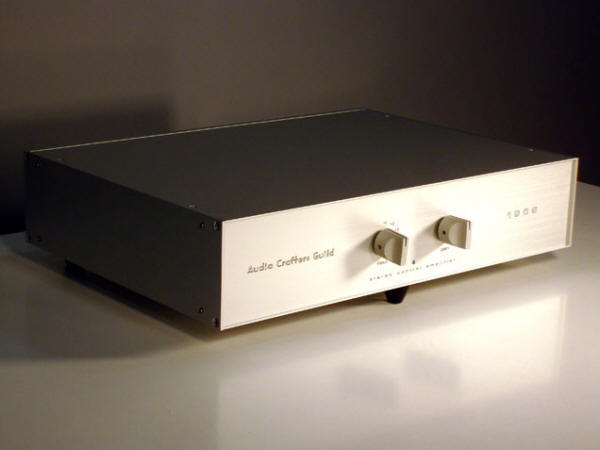
The Audio Crafters Guild 1000 Stereo Control Amplifier
Based on the highly regarded (and somewhat controversial) B&O ICEpower™ amplifier modules (which now appear in a variety of amplifiers ranging over a significant price range), the Audio Crafter's Guild has constructed a line of quite reasonably priced, high output (1000 watts) amplifiers for use in a variety of applications.
I took receipt of a pair of the balanced version monoblocks some time ago and their new integrated "control amplifier" more recently. While I marginally prefer the sound of the mono blocks (most likely because I am fronting them with an older JENA Labs designed preamplifier), they are predictably similar in presentation.
The monoblocks are shoebox-sized units, weighing only a few pounds. This very fact increases their utility significantly. Imagine two-thousand watts you can tuck under your arms without appreciable effort.
After shifting them around in various applications I have found them to be the perfect Home Theater amplifier. Compact, no significant heat or power consumption at idle, extremely powerful with a particularly adroit treatment of the kinds of transient signals that so often characterize home theater demands, and able to drive a considerable range of speakers.
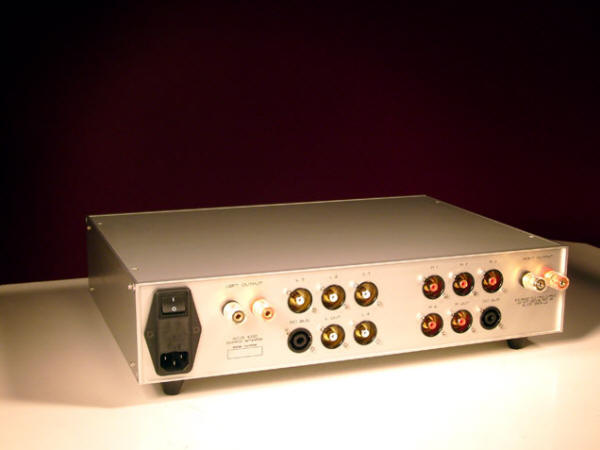
Rear view of the ACG 1000 Stereo Control Amplifier
One could easily create an extraordinarily powerful and adept multi-channel system around these units. At under $3,000 the pair, they represent a good alternative for those seeking to move beyond the anemic all-in-one receiver boxes out there.
They also make a great choice for amplifying passive subs, as an alternative to the more modestly constructed plate amplifiers so much in use …or for bass amplification in a bi-amplified system.
Much later I received the "integrated" version of these amplifiers (the Control Amplifier 1000) …which features the basic controls of an integrated amplifier fronting two channels of amplification …again, compact, well constructed and quite powerful.
Ultimately, this unit was paired with the DCM-TFE-60 and the Raysonic 128 CDP. In this combination, the integrated works beautifully.
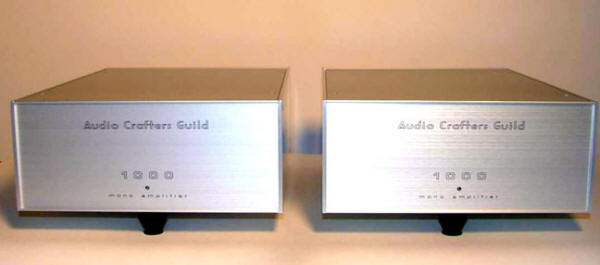
The Audio Crafters Guild 1000 monoblock amplifiers
But Again: How do They Sound?
Audio Crafter's claim to fame is a significant portion of the "high-end" performance at a more affordable price. I think this claim is justified, with one caveat I think they may have already addressed.
The ACG monos achieve a significant portion of the sound of much more expensive solid-state amplifiers, until pushed really hard (and I mean really hard). I know a thousand watts sounds like a lot, but without sufficient power reserves, heavy demand can result in a certain hardening and hashiness in the sound. While I have not been able to obtain the optional power-modules (1000 Energy Pack, $995), I suspect they were developed in response to this issue, giving users in critical audio applications the ability to provide the modules with a stiffer and more robust power supply. I would imagine this optional "add on" should resolve my primary sonic complaint.
Another approach is to do as I did, which was to pair the stereo control amplifier up with a warmish source and speakers that did not present too difficult a demand. And under no circumstances use the output terminals to drive active subs …the amplifiers do NOT like this at all. It is the only time they misbehaved even slightly.
In combination with the DCM 2-ways, I never heard a trace of the demand-effect I noted above. The sound remained quite smooth and without hardness or grain.
I used the monos in combination with a wide range of speakers, and other than as noted, they performed very well, certainly equaling the manufacturer's claims. Driving them hard and often in my primary home theater system, they have performed in an exemplary manner.
In total, I have had the Audio Crafter's amplifiers in continuous service for quite some time … and apart from my minor reservations about driving them hard in audio-critical applications, they have been faultless in operation and enormously enjoyable.
This is the first time I have had one of the new generation class-D digital switching amplifiers in review, and the experience has been quite encouraging.
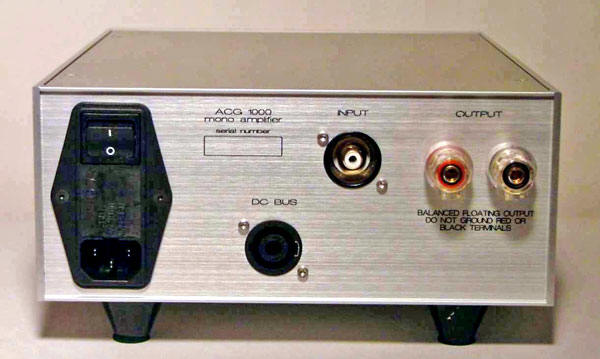
Audio Crafters Guild ACG 1000 monoblock amplifier, rear view
Specifications (adapted from manufacturer's materials)
-
Output power: 1000W @0.2%THD+N (Per amplification channel, unless otherwise specified)
-
Distortion: THD+N 4ohm F=100Hz, P =1W 0.007 0.015 %
-
Max THD+N: 4ohm 10Hz<F<20kHz
-
FTC rated output power 0-3kHz (output filter limit) @ 4 ohm: 150 W
-
Output referenced idle noise A-weighted: 10Hz < f < 20kHz
-
Nominal Voltage Gain: f = 1 kHz 26.7 27.2 7.7 dB
-
Frequency response: 20Hz - 20kHz, All loads ±0.5 ±1.0 dB
-
Abs. output impedance: f = 1kHz 5 10 mOhm
-
Load impedance range: 2-4 open circuit ohms
-
Dynamic range A-weighted: 115 118 120 dB
-
Idle dissipation Audio power out: 0 W-15.8
Retail: 1000 amplifier(s), $2590 the pair and the 1000 Stereo Control Amplifier (not available at press time)
Audio Crafters Guild
web address:
www.audiocraftersguild.com

DCM TFE60 2-way "Book Shelf" Speaker
For us old guys, DCM is a name we remember from the 1970s, when the DCM "TimeWindow™" speakers were often offered as less expensive, more practical alternatives to Quads, Magnepans and the other esoteric darlings of audiophiles in the early days.
Time passes and keeps on passing …and DCM (currently a division of Mitek Audio Corporation) are now largely engaged in home theater speaker design and sales. The speakers are designed in North America and manufactured in China (an increasingly common situation).
The TFE60 is a very inexpensive, largish, moderately sensitive, nicely constructed two-way, ported bass reflex "book shelf" speaker. They are biamp/bi-wirable and are available in stain black and wood grain.
They are also the least expensive speaker I have reviewed to date.
Frankly, at this price point I didn't expect much. Most of what I have heard around this level in the market has been seriously compromised and barely listenable. And there is a veritable horde of relatively inexpensive two-way speakers on the market, all vying for attention. In the midst of all this competition, I am not going to try to make the case the DCMs are "magical," but they are damned good at the price.
In spite of the perforated metal grill (which probably makes sense in the battlefield that is most households with children) the 60s are remarkably smooth and musical (but better with the grill off, which is not so easy to accomplish).
As improbable as the match may seem, the combination of the Raysonic 128, the Audio Crafter's Guild 1000 watt integrated and the DCM speakers as pleasing as one could hope for from a modestly sized secondary system.
With the upcoming departure of my long-time two-way reference, the ACI Sapphires, I popped the DCMs into my second combo system (home theater and 2 channel audio), also known as the torture system, where they have been acquitting themselves just fine. They lack the richness and detail of the ACIs, but are quite listenable, nonetheless. Quite a feat at one-third the price of the ACI's.
I understand this sniffy dismissal of home theater targeted products in the audio high-end, but dipping occasionally and selectively into this vast product pool can produce some surprisingly adept pieces at good values (such as the SLS two-ways reviewed in Part One of this "Gaggle" series; see https://positive-feedback.com/Issue34/hsu.htm).
Remember, the home theater field is a value/volume-driven market. While we audiophiles don't even blink at two thousand dollar speakers, the home theater folks will largely cough up a lung at those sorts of prices. Now, it is true that this often results in mass-market junk, but not always …and it is this "not always" zone where the adventure lies.
Kind of like a wine connoisseur finding a great bottle of Cabernet at under $10. Anybody can find great expensive wine!
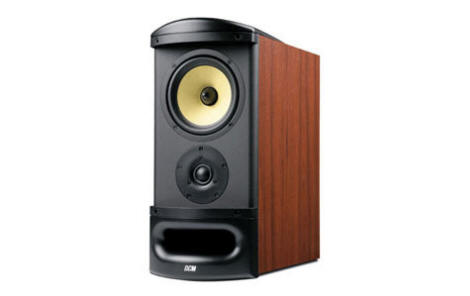
General
Fit and finish are very good for this price. While the "cherry" veneers on the sides were nice, the top plate, which features a curious molded plastic carapace, cheapens the effect somewhat.
I will state for the record that the metal grill (which requires a specific Allen wrench, and is not supplied) is a pain in the ass.
My second criticism is, to one degree or another, directed at most speaker manufacturers …and I have ranted on this before …terminals.
What IS it in people's thinking that suggests that small, tightly spaced speaker terminals are a GOOD idea? Makes me pine for the days of spring-loaded bare wire terminals …at least those worked …mostly.
If we are going to continue to have no standardization in how we connect speakers, at least make the terminals large enough and spaced widely enough that someone who lacks watchmaker fingers and tools, can actually use them without extended fumbling, bleeding, and cursing.
"Uh, yeah - but how do they sound?"
While they lose a bit of resolution and snap when connected to the otherwise excellent Tonewin (see Part One of "Gaggle," https://positive-feedback.com/Issue34/hsu.htm) hybrid integrated, with the leaner and more powerful Audio Crafters integrated amplifier they are nicely extended, smooth and quite adequately resolving. I think an affordable SS integrated amplifier is the best choice for this speaker. Bass response (actually as with most two-ways, it is more mid-bass) is reasonable but they are really designed for use with subs. DCM makes relatively inexpensive companion subs.
Mated to the terrific Hsu powered ten-inch sub (at the same link in the above paragraph), they do a very respectable job for both 2-channel audio and smaller scale home theater. Nodding towards the warm side, they would be an excellent choice with a host of modestly priced mass-market solid-state amplification out there, and since the entire DCM home theater system retails for less than $2000 (sans sub), it forms an affordable alternative to the higher priced spread (such as a comparable SLS system).
An Oppo 980, a reasonably good solid-state integrated and a pair of DCMs would work very well for either a secondary or economy system.
In secondary audio and home theater systems, I find the DCM to offer excellent value and good sound. For the price, these are hard to beat.
Specifications (adapted from manufacturer's information)
-
Drivers: One 30mm Dome Tweeter, One 6.5" Midrange-Bass unit
-
MFR: 42 Hz – 20 kHz
-
Nominal Impedance: 6 Ohms
-
Sensitivity: 88 dB
-
Dimensions: 17.5" H x 8" W x 16" D
-
Weight: 64 Pounds each
Retail: $249.95 each
DCM
Loudspeakers
web address:
www.directdcm.com
TEL: 800. 372. 3029 (7:00 a.m. – 5:00 p.m. Central Time USA)
